10 million lives could be lost to superbugs - so how far have we got in the race to beat them?

British scientists claim they have beaten more than a dozen rival teams around the world in the race towards a new synthetic antibiotic. They hope that the agent – an improved version of a natural antibiotic called teioxobactin, discovered in soil by American scientists in 2015 – will provide a new treatment for resistant hospital superbugs and a range of other infections that are becoming impervious to our battered medicine cupboard of 20th century antibiotics.
The group from Lincoln University, the site of a new medical school due to open its doors in September, has been collaborating with groups from Liverpool University, as well as academic researchers in the Netherlands, Belgium and Singapore, to achieve the advance.
Their data, just published in the Journal of Medicinal Chemistry, provides the first evidence using mice that the treatment can knock out methicillin-resistant staphylococcus aureus and vancomycin-resistant enterococci, both of which appear on a new World Health Organisation list of 12 “priority pathogens” – treatment-resistant families of bacteria that represent the biggest threats to human health.
Their work is an advance, but not yet a game-changer.
Latest data from the authoritative Philadelphia-based Pew charitable trust which is tracking progress in superbug war, indicates there are 80 possible new antibiotic drugs, vaccines and other “non-traditional” candidate products in development round the world, which could save us from losing the war against new generations of killer infections.
The need has never been more urgent. A recent global study from a team at Johns Hopkins University in Baltimore, Maryland, showed the problem has been fuelled by an astonishing 65 per cent increase in antibiotic use between 2000 and 2015.

Current UK government projections indicate that by the time today’s primary school children reach adulthood, deaths from infectious illnesses will claim at least 10 million lives a year worldwide and limb amputations to halt the spread of infection will become commonplace – unless we find new treatments.
“We are optimistic,” saya Dr Ishwar Singh, a specialist in novel drug design and development who is leading the Lincoln project. “We are the first people worldwide to achieve this step. We have not only proved our treatment kills the bacteria, but we have also shown it reduces inflammation at the same time.”
The results so far are only in mice, but Dr Singh is in talks with three pharmaceutical industry investors and he hopes the product will go into human trials in as little as three years.
Not far from Lincoln at the University of East Anglia in Norwich, Professor Chagnjiang Dong, an expert in molecular medicine, is also forging ahead with a different candidate weapon: a treatment that blocks construction of the two-layer cell walls protecting virulent so-called gram-negative bacteria, which include resistant strains of salmonella, E.coli and legionella, all of which regularly cause fatal outbreaks of disease.
Professor Dong is as upbeat as Dr Singh: “We think we have found a very good target for a new treatment. I am very optimistic about where this will lead,” he says

Over in Leicester, Professor Martha Clokie, another infectious diseases expert, is working on phages – tightly targeted viruses that attack disease-causing bacteria, which could provide an answer to the search for a new way of destroying antibiotic-resistant superbugs. She is similarly hopeful but, like the others, needs more investment to develop her work.
Until now, the problem has been bubbling away below the surface. Official figures indicate about 5,000 people a year in the UK are dying from illness that could previously be treated by penicillin and its myriad derivatives. Many authorities believe the real figure is 10,000 deaths or more, but it is still a number that looks irrelevant compared with the 300,000-plus who die from cancer and heart disease.
However, increasing numbers of superbug survivors are coming forward with accounts of the horrific damage that may affect many more of us. In February, Magdalena Malec, 31, from Dunstable, Beds, described how she lost a kidney, plus both legs, her right arm and fingers of her left hand, from a superbug infection during routine treatment to remove an ectopic pregnancy.
A few weeks later, Ben May, a 25-year-old Oxford graduate and keen athlete from Haslemere, Surrey, told how he narrowly escaped amputation but suffered life-threatening illness and eight operations after he contracted a hospital superbug following surgery for a soccer injury.

Also last month, Dee Struthers from the Isle of Man, who set up a charity after her 18 year-old daughter Ann died in 2013 from a superbug throat infection, presented her local emergency services with a lactate monitor, a device to show when antibiotics are not working. “Perhaps if Ann’s blood had been tested with such a monitor, we would be sharing a different story today,” she said.
A further worrying development was reported last month by Public Health England, who revealed doctors were battling with the a new treatment-resistant version of the common sexually transmitted gonorrhea, an infection that can cause permanent infertility. The male victim is believed to have survived, but no details have been published.
Antibiotics work by destroying the cells walls of disease-causing bacteria, disrupting their repair mechanisms, or preventing cell multiplication. Existing treatments are called broad-spectrum, meaning they work against varieties of different bacteria. Doctors have prescribed them indiscriminately secure in the knowledge that knocking out a variety of different species at the same time will probably include the one causing the infection.
Although the treatment has been liberally overused in the UK, overuse has been even worse in the developing world. In addition, countries that permit routine use of antibiotics for pre-emptive dosing of intensively reared chickens, pigs and cattle to prevent spread of infection in their cramped and unhygienic living conditions has only encouraged the survival and proliferation of the deadliest bacteria, whose mutations have now made them resistant to existing drugs.

“There’s no doubt that the rate of antibiotic resistance is accelerating,” says Nick Brown, a Cambridge medical microbiologist who directs a global public awareness campaign called Antibiotic Action. “Attracting investment for new antibiotics is difficult. Despite the scale of a problem, which is ranked alongside terrorism and global warming as a major threat to mankind, drug companies can make much more money out of treatments for heart disease and cancer.”
In the past two years however, levels of anxiety among doctors have been ratcheted up by new warnings from the World Health Organisation (WHO), the US Centers for Disease Control, and an influential report commissioned by Britain’s chief medical officer Dame Sally Davies from Professor Jim O’Neill, a global authority on bacterial infection.
Professor O’Neill whose report concluded 10 million lives could be lost to superbug infections by 2050, says: “Key medical procedures such as gut surgery, caesarian sections, joint replacements and treatments that depress the immune system such as chemotherapy for cancer, could become too dangerous to perform.”
The WHO also fears the lack of commercial incentive for pharmaceutical companies to develop antibiotics. Last March, it published a list of 12 “priority pathogens”, including new treatment-resistant versions of run-of-the-mill bugs which routinely cause food poisoning, stomach and chest infections.
“This list is a new tool to ensure [drug] researchers and developers respond to urgent public health needs,” said WHO spokesman Dr Marie-Paule Kieny. “Antibiotic resistance is growing and we are fast running out of treatment options. If we leave it to market forces alone, the new antibiotics we most urgently need are not going to be developed in time.”
And that is the problem. “We want to encourage the development of new drugs that are expensive to produce and we also want to restrict their use,” says Lloyd Czaplewski, an antibiotic investment consultant. “We need to decouple use from profit. It’s a bit like having a fire extinguisher: you pay a lot for it, but you hope never have to use it.”
In addition to the search for new antibiotics, other anti-superbug treatments include short-acting vaccines, targeted anti-bacterial antibodies or agents to attack specific bacterial properties; and probiotics – “good” bacteria designed to crowd out disease-causing bugs.
Meanwhile, phages – the viruses capable of infecting and destroying targeted disease-causing bacteria – have been dramatically successful for some people. Tom Patterson, 71, a professor of psychiatry at the University of California in San Diego, is one of the highest profile beneficiaries of the technique. He almost died from septic shock after all known antibiotics were ineffective against an infection from a resistant bug called acinetobacter baumannii, which he contracted on holiday in Egypt two years ago. It was only through his medical contacts that he was able to get a targeted bacteriophage from the former Soviet republic of Georgia.
“It was quite simply, a miracle,” said Professor Patterson, who had been expected to to die. “Within two days of receiving the therapy, I was getting better.”
If we’re going to make progress, we need attitudes to change so people realise antibiotic research is just as important
The phage technique was developed behind the Iron at a time when antibiotics were hard to come by. Although it is now being investigated as an alternative to antibiotics, it is fearsomely expensive, with each phage having to be tailored to an individual patient.
A variety of international collaborations have formed to tackle the problem of funding for unprofitable treatments designed to be used as sparingly as possible. The biggest investor has been the European Union’s Innovative Medicines Initiative (IMI) which since 2013 has been overseeing a vast £620 million joint project between industry, academia and biotech companies.
The IMI collaboration is also co-operating with another joint project, Combating Antibiotic Resistant Bacteria BioPharmaceutical Accelerator (CARB-X), funded by the US government and the London-based Wellcome Trust medical charity. It has a £320 million commitment to identify 20 potential new antibiotics and get at least two of them into human trials by 2021.
Alongside this is the World Health Organisaton’s £240 million Global Antibiotic Research and Development Partnership (GARD-P), which is hoping to produce new potent forms of four existing antibiotics by 2023.
Despite these apparently vast levels of investment, Czaplewski says getting a candidate treatment to a stage where it may be considered for next-level funding is still too expensive for many ideas to get off the ground. “The charity sector is very under-represented in this field and that needs to change,” he says. “At the moment, there is a cancer research building on virtually every major university campus. If we’re going to make progress, we need attitudes to change so people realise antibiotic research is just as important.”

 Yahoo News
Yahoo News 
